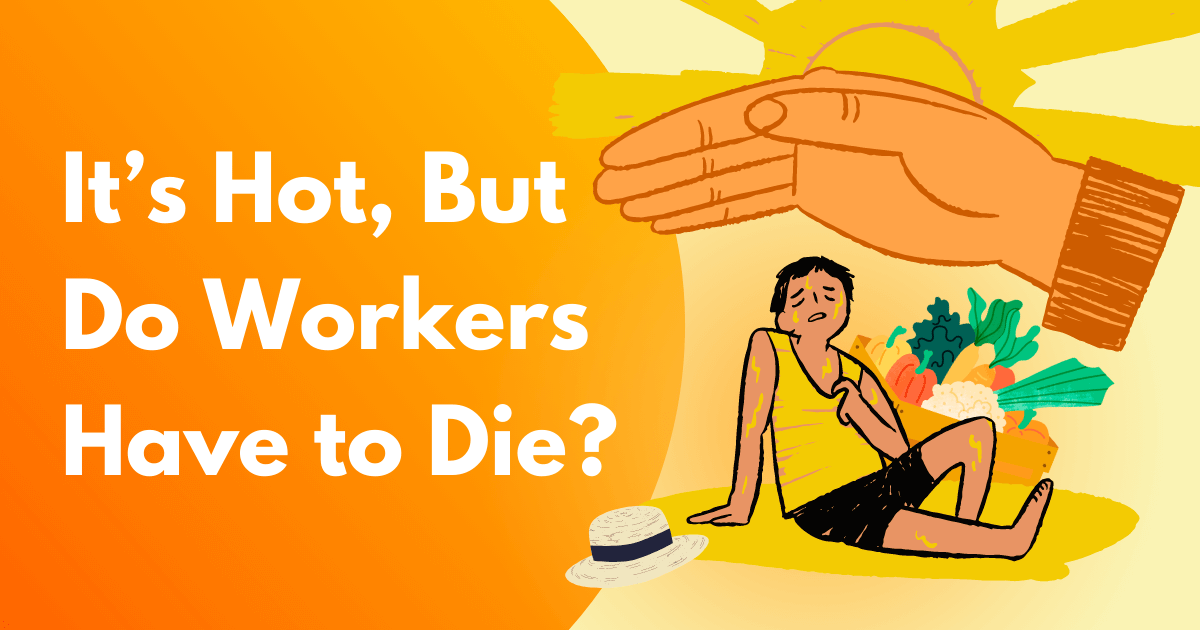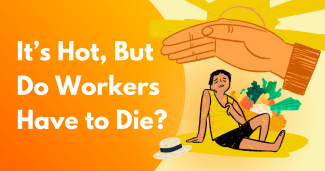It’s Hot, But Do Workers Have to Die?

[Editor’s Note: This is the first in a series of posts on the impact of heat on the communities we serve which we will run through the summer.]
June 2023 was the hottest month on record. Last Monday, July 3rd, was the hottest day this planet has ever seen – until Tuesday came along. Then Thursday became the hottest day ever, capping the four consecutive hottest days on Earth in the last 120,000 years -- but you likely didn’t hear about it because the news cycle found the record-breaking too mundane. Meanwhile, the oceans – particularly the North Atlantic -- are heating up in terrifying and unprecedented ways. You’re not imagining it; we are breaking records over and over again. This year, the climate crisis is colliding with El Niño, a phenomenon of warmer ocean currents in the Pacific Ocean that increase temperatures, that itself may be becoming more frequent because of climate change. But breaking records, while it is becoming the norm, cannot lead to complacency.
"This is not a milestone we should be celebrating — it's a death sentence for people and ecosystems," said Friederike Otto, a climate scientist at the Imperial College London's Grantham Institute for Climate Change and the Environment.
Heat kills, and not everyone is equally exposed to excessive heat. In the United States, low-wage outdoor workers of color are perhaps the most exposed, and many are dying of heat. Farmworkers, day laborers, and construction workers may not be provided opportunities to take shade, rest, or water breaks, while indoor workers without air conditioning like people employed in warehouse and delivery are often overlooked when it comes to heat stress. During the recent “heat dome” in Texas, Eugene Gates, a postal worker in Dallas, and Felipe Pascual, a construction worker in Houston, died of heat exhaustion. Already this summer, thousands of workers likely experienced heat stress, with several factors like workload, work duration, payment method, and other poor workplace conditions identified as associated with heat-related illness among farmworkers. With the growing heat, thousands more will become ill or die.
And regulators are not keeping up with the threat.
“The climate has changed. The crisis is here. It’s not some far-off thing. And it’s killing workers. It’s killing children. It’s killing people. And it will keep killing. Yet, we are failing to protect those who are most vulnerable as safety regulations are needed now more than ever,” said Amy Liebman, MPA, Chief Program Officer of Workers, Environment, and Climate at Migrant Clinicians Network.
In the midst of unprecedented heat, some states are reducing protections. In Texas, Governor Greg Abbott recently signed a bill that would suspend worker heat protections that individual cities have passed, requiring those cities to drop their rules as they aren’t in line with Texas-wide regulations. In the case of heat-related illnesses, Texas has zero regulation; under the new rule, all cities must have zero regulation for heat stress. Some states, however, have taken a different approach.
“While there is no federal standard to protect workers from heat, it’s heartening to see that states are filling the gap with state heat standards,” Liebman noted. “And guess what? The economies and businesses in these states haven’t suffered as a result.”
Heat standards require basic steps to protect workers. California’s heat standard, for example, requires employers to provide cool water that is close to where the employees are working. When temperatures surpass 80 degrees, shade must be provided, and when temperatures reach 95 degrees, farmworkers must be provided 10-minute breaks every two hours to take advantage of the shade and water. A new proposed standard will protect indoor workers in unconditioned environments as well.
“But we don’t just need standards,” Liebman added. Migrant Clinicians Network provides extensive resources and train-the-trainer community participatory trainings to help ensure that communities are ready for the heat. Training and community advocacy is essential, in the absence of standards as well as when they come online, to make sure workers recognize heat stress and take care of themselves and fellow workers, and advocate for safe workplaces.
Additionally, on a larger scale, we need to advocate for the rapid cessation of global dependence on fossil fuels. With each fraction of a degree of warming, the danger for outdoor workers increases. While we are locked into at least 1.5 degrees of warming, higher levels of warming are still on the horizon unless our planet’s infrastructure rapidly shifts. While this is a large and expensive endeavor, ultimately it will save the most lives and protect our agricultural products and systems from extensive and long-lasting heat damage, and will likely shield the economy from disasters and breakdown as well.
“Addressing the climate crisis is the single most important thing we can do to protect worker health,” Liebman concluded. “As the climate crisis rages on, more workers will die, unless we act.”
- Log in to post comments
